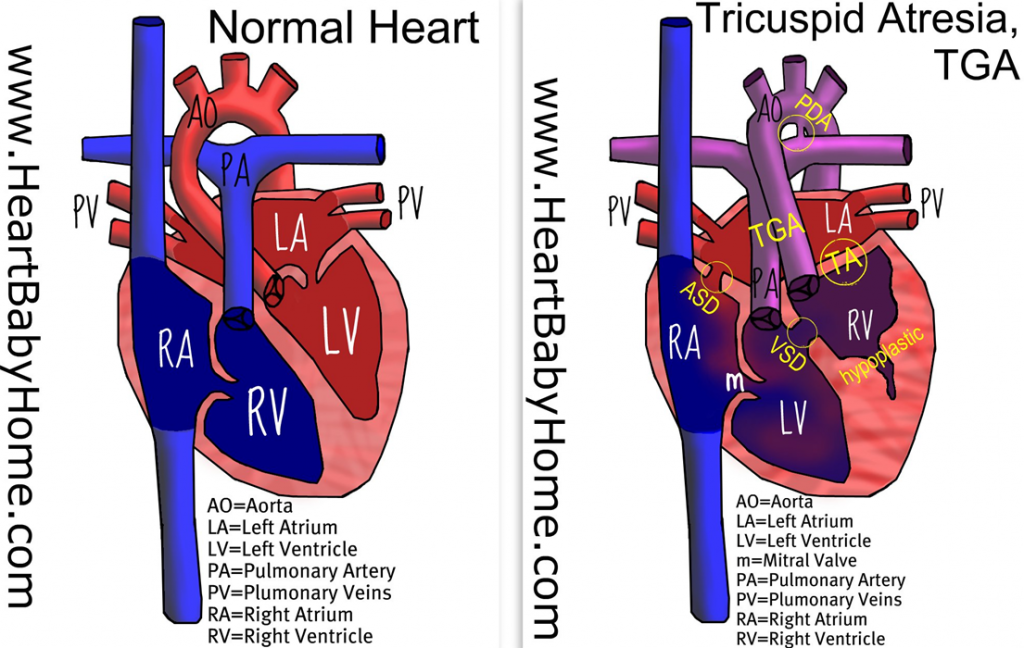Normal Heart vs. Evan’s Heart
I thought it would be good for everyone, especially me, to learn how the heart is supposed to work and how that is going to differ from little Evan’s heart. Once we understand how the hearts differ we can start to talk about what the doctors are going to do to make Evan’s heart work for him.
A Normal Heart
Watch this quick video to learn about how a normal heart functions.
Tricuspid Atresia
Congenital heart defects (CHD) are the most common type of birth defect, affecting 8 of every 1,000 births. This year, Evan will be among the 35,000 babies in the US born with a CHD. Evan’s heart condition is called tricuspid atresia, an uncommon form of congenital heart disease that affects about 5 in every 100,000 live births. He will have approximately 211 other fighters in this rare club born this year. Twenty percent of patients with this condition will also have other heart problems. Infants with tricuspid atresia generally are cyanotic (bluish discoloration of skin) and easily become short of breath. In addition, there is a greater likelihood of cognitive developmental issues and there may be abnormalities of other organs. In many cases, it is unknown why the defect occurred nor anything that could have been done to prevent it.
There are several different types of tricuspid atresia:
Type 1: People with normally related great arteries and occurs in 70-80% of cases. (148-170 born this year in the US)
Type 2: People with d-transposition of the great arteries and occurs in 12-25% of cases. (25-53 born this year in the US)
Type 3: People with more complex issues such as l-transposition of the great arteries and occurs in only 3-6% of cases. (6-13 born this year in the US)
Evan is suffering from tricuspid atresia with levo-transposition of the great arteries, type 3.
Let’s break each of those terms down:
Tricuspid – refers to the tricuspid valve, the valve between right atrium and the right ventricle. This valve allows the de-oxygenated blood into the right ventricle where it is then pushed to the lungs.
Atresia – a condition in which a body orifice or passage in the body is abnormally closed or absent.
So tricuspid atresia refers to the lack of a tricuspid valve. Instead of where the valve should be exists a solid wall of tissue.
levo-Transposition of the great arteries (l-TGA) – refers to the transposition of both the great arteries (aorta and pulmonary artery) as well as the transposition of the left and right ventricle. In other words, the arteries pumping to the lungs and body are attached to the wrong ventricle and the ventricles are on the opposite side of the heart that they should be.
Here is a comparison of a normal heart with a TA with l-TGA heart:
During our first echocardiogram at 24 weeks, the cardiologist suspected TA/L-TGA instead of HLHS due to several things:
- There is a hypoplastic ventricle on the right side
- Evan is missing one of the valves in his heart
- The valve that is present is a bi-cuspid valve and has a certain attachment structure. It is the mitral valve. The missing valve is therefore the tricuspid valve (Tricuspid Atresia or TA)
- The ventricle that is present is identified by the valve that empties into it. The mitral valve empties into the left ventricle (LV), so the right ventricle (RV) is hypoplastic.
- The LV and RV have developed on the opposite sides of the heart (L-transposition)
- Due to the transposition, the LV empties into the pulmonary artery instead of the aorta and the RV empties into the aorta instead of the pulmonary artery (Transposition of the Greater Arteries or TGA)
- The aorta is normally developed
- There are holes between the two atria and between the two ventricles (described below)
The right ventricle (RV) is abnormally small (hypoplastic) and non-functional. It does not pump blood. This occurred because with the absence of the tricuspid valve (TA in the image) there was not adequate blood flow into the chamber to “inflate” the heart and assist in development.
Also labeled in the diagram are the ASD, PDA, and VSD. Let’s talk about these briefly.
ASD – Atrial Septal Defect – a hole or opening between the left and right atria of the heart, causing oxygen poor and oxygen rich blood to mix. Critically necessary for Evan to live. If he wasn’t born with one, they would need to surgically make this hole (procedure called atrial septostomy) or ensure the patent foramen ovale doesn’t close after birth (by using prostaglandin drugs)
VSD – Ventricular septal defect – a hole or opening between the left and right ventricle, causing oxygen poor and rich blood to mix. Critically necessary for Evan to live. Without this opening, oxygen-rich blood could not travel through the aorta to the body (in a roundabout way: through the left atrium, ASD, right atrium, left ventricle, VSD, right ventricle, and finally the aorta)
PDA – Patent Ductus Arteriosis – Before birth, the ductus arteriosus allows blood to bypass the baby’s lungs by connecting the pulmonary arteries (which supply blood to the lungs) with the aorta (which supplies blood to the body). Soon after the infant is born and the lungs fill with air, this blood vessel is no longer needed. It will usually close within a couple of days. If the ductus arteriosus does not close, there will be abnormal blood circulation between the heart and lungs and it is called patent ductus arteriosis (PDA). PDA is common in babies with congenital heart problems, such as hypoplastic left heart syndrome, transposition of the great vessels, and pulmonary stenosis.
Now that we understand the differences between a normal heart and one with TA/l-TGA, lets talk about what can be done to “correct” the issues. Click here to move on to treatment of TA/l-TGA.

